Sabona Wildlife Safari Day 2

Take Off
Jörgen Wennberg
Tue 19 Dec 2017 12:00
DAY 2 At 5.30 am up early birdy for the sunrise safari. The animals are most active during Sunrise & Sunset. Coffee to wake us up...   … but for some it was still too early.   Only 30 min later when the sun was still quite low and we enjoyed the Impalas and   the elephants by the water.  As we enjoyed the beauty of nature just waking up on our left hand side, turning around to our right hand side, it suddenly just stood there. A Cheetah. Majesticulously contemplating the early hours of the day.   Slowly it walked down towards us,     passing only a few 50 m from our car. The Cheetah showed to be the kids absolutely favourite animal and far into the circumnavigation, the Cheetah was the only one they always talked about.  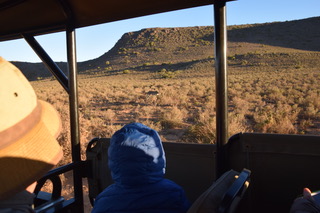 The Southeast African cheetah is the nominate cheetah subspecies native to East and Southern Africa. ]The Southern African cheetah lives mainly in the lowland areas and deserts of the Kalahari, the savannahs of Okavango Delta, and the grasslands of the Transvaal region in South Africa. A very happy and special moment for all of us.   Alex continuing talking about the Cheeta.   Further away we stopped for our morning brake having a well deserved coffee. The morning was very frisky and pretty cold. Douglas was so cold, luckily our guide had a blanket for him.   The Boys The Girls The Kids      Beautiful morning light  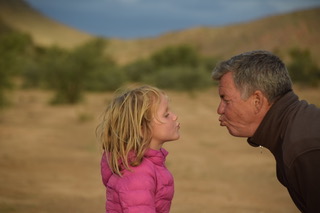   Next thing we ran into a turtle!   This part was also very special : visiting the Buffalos. The sign was right, there many of them! A very impressive animal you do not want to mess around with. The African buffalo, or Cape Buffalo is the largest one in Southern and East Africa. The adult African buffalo's horns are its characteristic feature: they have fused bases, forming a continuous bone shield across the top of the head referred to as a "boss". It is widely regarded as one of the most dangerous animals on the African continent, and according to some estimates it gores, tramples, and kills over 200 people every year. The African buffalo is not an ancestor of domestic cattle and is only distantly related to other larger bovines. Its unpredictable temperament may have been part of the reason that the African buffalo has never been domesticated, unlike its Asian counterpart, the water buffalo. Natural predators of adult African buffaloes include lions, hyenas, and large crocodiles. As a member of the big five game, the Cape buffalo is a sought-after trophy in hunting.  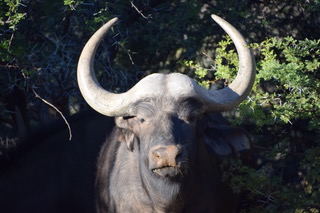   We were very weary watching the Buffalos not being too curious about our car.  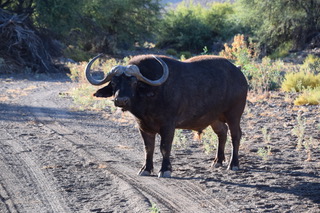  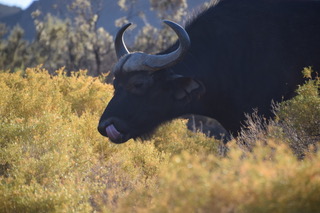 Only a few kilometres away we encountered an Elephant Family.     As well as Kudus.   Further away, we were lucky to meet the Giraffes. The South African giraffe or Cape giraffe is a subspecies of giraffe ranging from South Africa, Namibia, Botswana, Zimbabwe, Mozambique. It has rounded or blotched spots, some with star-like extensions on a light tan background, running down to the hooves. In 2016, the population was estimated at 31,500 individuals in the wild.     Later on, we met the Common Elan. The common eland, also known as the southern eland or eland antelope, is a savannah and plains antelope found in East and Southern Africa. It is a species of the family Bovidae. An adult male is around 1.6 metres tall at the shoulder (females are 20 centimetres shorter) and can weigh up to 942 kg with an average of 500–600 kg, 340–445 kg for females. It is the second largest antelope in the world. It was scientifically described by Peter Simon Pallas in 1766. Mainly an herbivore, its diet is primarily grasses and leaves. Common elands form herds of up to 500 animals, but are not territorial. The common eland prefers habitats with a wide variety of flowering plants such as savannah, woodlands, and open and montane grasslands; it avoids dense forests. It uses loud barks, visual and postural movements and the flehmen response to communicate and warn others of danger. The common eland is used by humans for leather, meat and milk, and has been domesticated in many areas. Eland milk contains more butterfat than cow milk, and can keep longer without pasteurising. The common eland's population is decreasing, so it is classified as of Least Concern by the International Union for Conservation of Nature(IUCN).   Back to the Lodge for Lunch and rest.  A pretty nice and relaxing afternoon and we were totally alone by the pool! 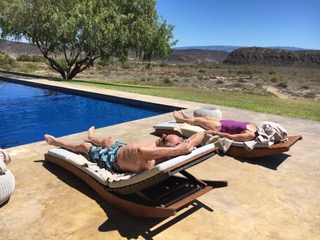  Before we went for our afternoon guided tour, we visited the animal park behind the lodge.       Sabona Wildlife had this great “Poo” booklet for the kids, collecting poos from different animals. Alex and Inez were really eager to collect everything for their booklet. 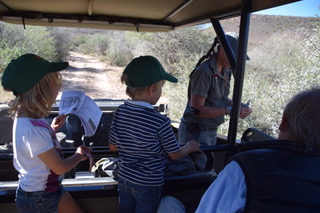     To explain the elephant poo, our guide showed what the elephants eat. Quite inimageable to see how the elephants can manage to pick the green leaves from these very sharp and spiky bushes.   And this is the result, goes straight through the bowls and still come out … as grass.     Meeting more Rhinos! The black rhinoceros or hook-lipped rhinoceros is a species of rhinoceros, native to eastern and southern Africa. Although the rhinoceros is referred to as black, its colours vary from brown to grey. The other African rhinoceros is the white rhinoceros. The word "white" in the name "white rhinoceros" is often said to be a misinterpretation of the Afrikaans word wyd (Dutch wijd) meaning wide, referring to its square upper lip, as opposed to the pointed or hooked lip of the black rhinoceros. These species are now sometimes referred to as the square-lipped (for white) or hook-lipped (for black) rhinoceros. The species overall is classified as critically endangered (even though the south-western black rhinoceros is classified as near threatened). Three subspecies have been declared extinct, including the western black rhinoceros, which was declared extinct by the International Union for Conservation of Nature (IUCN) in 2011.     Our last night we had a Braai. What is a South African braai? A braai is South Africa's answer to the barbecue – but it's so much more than that. It's a special South African feast that can last for hours, and there are plenty of rules and etiquette around a classic braai. The most important part of a braai is the fire.    |